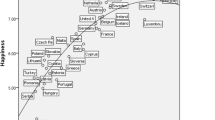Abstract
In the wake of China’s enormous success transitioning to a market economy there is a widely held belief among researchers and policymakers that the country’s income distribution has become excessively unfair. Previous authors have argued ‘the perception of inequality is one of the key elements of the attitudes toward reforms’. We hypothesize that reform ‘winners’ (educated, high income, higher ranking Party officials) will express less dissatisfaction with the current income distribution and reform ‘losers’ (less educated, lower income, lower ranking Party members) will express greater dissatisfaction with the current income distribution. To test this hypothesis we use two unique data sets, the 2002 Chinese Household Income Project and the World Values Survey. We find that the perception of unfairness is highly correlated with actual or perceived income, current prospects, attitude toward corruption, and status of Party membership.



Similar content being viewed by others
Notes
See Lee (2000) for an explanation for the dip in the Gini between 1995 and 2000.
We consider the urban households only as they provide a more reliable measure of household income. We examine only the ‘inequality in the nation’ responses as the city responses are quite similar.
See Appendix for a description of ordered logit.
In Table 7 we compare CHIP results with WVS data, which lacks a subjective income variable. In this case education is statistically significant.
References
Alesina, A and Angeletos, G-M . 2005: Fairness and redistribution. The American Economic Review 95 (4): 960–980.
Chinese Household Income Project (CHIP). 2002: ICPSR21741-v1. Ann Arbor, MI: Inter-university Consortium for Political and Social Research, 2009-08-14. doi: 10.3886/ICPSR21741.v1.
Greene, W . 2012: Econometric analysis, 7th Edition. Prentice Hall: Upper Saddle River, NJ.
Grosfeld, I and Senik, C . 2010: The emerging aversion to inequality: Evidence from subjective data. Economics of Transition 18 (1): 1–26.
Han, C and Whyte, MK . 2008: Popular attitudes toward distributive justice: Beijing and Warsaw compared. Journal of Chinese Political Science 13 (1): 29–51.
Han, C and Whyte, MK . 2009: The social contours of distributive injustice feelings in contemporary China. In: Davis, DS and Wang, F (eds) Creating Wealth and Poverty in Post-Socialist China. Stanford University Press: Palo Alto, CA. pp., 193–212.
Hu, J . 2005: People’s Daily (Renmin Ribao), 27 June.
Knight, J, Song, L and Gunaatilaka, R . 2009: Subjective well-being and its determinants in rural China. China Economic Review 20 (4): 635–649.
Lee, HY . 2000: Xiagang, the Chinese style of laying off workers. Asian Survey 40 (6): 914–937.
National Bureau of Statistics of China. 2000: Chinese Urban Household Survey, Beijing, China.
Riskin, C, Zhao, R and Li, S . 2002: China’s retreat from equality: Income distribution and economic transition. New York: Studies of the East Asian Institute, Columbia University.
Sanfey, P and Teksoz, U . 2007: Does transition make you happy? Economics of Transition 15 (4): 707–731.
The World Bank. 2012: China|Data|Economic Indicators. The World Bank, http://data.worldbank.org/country/china, accessed 23 February.
The Xinhua News Agency. 2005: Widening income gap, the most serious social problem in China. People’s Daily Online. 9 July, http://english.peopledaily.com.cn/200507/09/eng20050709_195106.html, accessed 23 Feburary 2012.
Wang, F and Davis, DS . 2008: Creating wealth and poverty in postsocialist china. Stanford University Press: Palo Alto, CA.
Whyte, M . 2010: Fair versus unfair: How do Chinese citizens view current inequalities? In: Oi, J, Rozelle, S and Zhou, X (eds) Growing Pains: Tensions and Opportunity in China’sTransformation. Walter H. Shorenstein Asia-Pacific Research Center: Stanford, CA.
World Values Study Group. 2008: World values survey, 1995–2008. ICPSR: Ann Arbor, MI.
Author information
Authors and Affiliations
Appendix
Appendix
Ordered logit specifications used in this paper
In this paper, we adopt a parsimonious logit specification and all the slope parameters are the same for different outcomes while each level of outcome is allowed to have a different intercept term. Suppose the unconditional probability of each outcome is denoted as p k =Prob(outcome=k), k=1, 2, 3, then the logit specification is given by the following:



This specification assumes proportional odds, as the odds ratio of the outcome Y≤k is independent of the category k. The odds ratio is assumed to be constant for all categories.
Rights and permissions
About this article
Cite this article
Bishop, J., Liu, H. & Qu, Z. Individual Perceptions of Distributional Fairness in China. Comp Econ Stud 56, 25–41 (2014). https://doi.org/10.1057/ces.2013.27
Published:
Issue Date:
DOI: https://doi.org/10.1057/ces.2013.27




